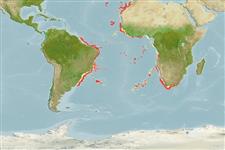Elasmobranchii (hajar och rockor) (sharks and rays) >
Squaliformes (Sleeper and dogfish sharks) >
Somniosidae (Sleeper sharks)
Etymology: Centroscymnus: centr[um] (L.), prickle or sharp point, referring to spines on both dorsal fins; scymnus, an ancient name for some kind of shark, derived from a Greek word meaning young animal, cub or whelp (See ETYFish); owstonii: In honor of Alan Owston (1853-1915), English businessman, yachtsman, and collector of Asian wildlife, who obtained holotype (See ETYFish).
Eponymy: Alan Owston (1853–1915) was an English businessman who was a collector of Asian wildlife, as well as a yachtsman. [...] (Ref. 128868), visit book page.
More on author: Garman.
Environment: milieu / climate zone / depth range / distribution range
Ekologi
marina djupbottenlevande; djupintervall 100 - 1500 m (Ref. 26346). Deep-water; 33°N - 38°S, 52°W - 30°E
Atlantic, Pacific and Indian oceans. Western Indian Ocean: from off the Seychelles to the Madagascar Ridge and South Africa. Eastern Indian Ocean off Indonesia and southwestern Australia. Southwestern Pacific: off Australia, New Caledonia and New Zealand. Northwestern Pacific: off Japan and from the Hawaiian-Emperor seamount chain. Southeastern Pacific: west of Chile. Southwestern Atlantic: off French Guiana, Brazil, and Uruguay. Northwestern Atlantic: Gulf of Mexico. Eastern Atlantic: from off the Azores in the North to off South Africa in the south.
Length at first maturity / Size / Vikt / Age
Maturity: Lm ?, range 100 - 104 cm
Max length : 148 cm TL hane/ej könsbestämd; (Ref. 122636); publicerad maxvikt: 21.3 kg (Ref. 122636)
Taggstrålar i analfenan: 0. Dark brown or black in color, dorsal fins with extreme tips of fin spines protruding from the fins, moderately long snout, lanceolate upper teeth and bladelike lower teeth with short, oblique cusps, fairly stocky body that does not taper abruptly from pectoral region, large lateral trunk denticles with mostly smooth, circular, cuspidate and acuspidate crowns in adults and subadults (Ref. 247).
Found on upper continental slopes, on or near the bottom (Ref. 247). Feeds on fish and cephalopods (Ref. 6871). Ovoviviparous (Ref. 205), with 16- 28 young born at 27-30 cm (Ref. 26346). Caught in trawls or longlines set at depths greater than 400 m (Ref. 55584). Flesh is high in mercury (Ref. 6871). Utilized as fishmeal and source of squalene (liver oil) (Ref. 6871). Maximum depth from Ref. 55584.
Ovoviviparous (Ref. 6871). 16- 28 young born at 27-30 cm (Ref. 26346). Distinct pairing with embrace (Ref. 205).
Compagno, L.J.V., 1984. FAO Species Catalogue. Vol. 4. Sharks of the world. An annotated and illustrated catalogue of shark species known to date. Part 1 - Hexanchiformes to Lamniformes. FAO Fish. Synop. 125(4/1):1-249. Rome, FAO. (Ref. 247)
IUCN Red List Status (Ref. 130435: Version 2024-1)
Threat to humans
Poisonous to eat (Ref. 6871)
Human uses
Fiskeri: mindre kommeriell
Verktyg
Special reports
Download XML
Internet-källor
Estimates based on models
Preferred temperature (Ref.
123201): 4.9 - 10.9, mean 6.4 °C (based on 66 cells).
Phylogenetic diversity index (Ref.
82804): PD
50 = 0.5313 [Uniqueness, from 0.5 = low to 2.0 = high].
Bayesian length-weight: a=0.00324 (0.00196 - 0.00534), b=3.16 (3.03 - 3.29), in cm total length, based on LWR estimates for this species & (Sub)family-body (Ref.
93245).
Trofisk nivå (Ref.
69278): 4.5 ±0.62 se; based on food items.
Resiliens (Ref.
120179): Låg, lägsta populationsfördubblingstid 4,5-14 år (Fec=16-28).
Fishing Vulnerability (Ref.
59153): Very high vulnerability (89 of 100).
Climate Vulnerability (Ref.
125649): Moderate vulnerability (38 of 100).
